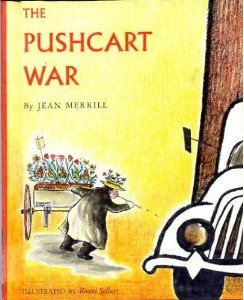The Pushcart War facts for kids
The Pushcart War is a popular children's book written by American author Jean Merrill. Ronni Solbert drew the pictures for the book, which was first published in 1964. It's the book Jean Merrill is most famous for. The story is told like a history report from the future. It looks back at a "war" that happened on the streets of New York City. This war was between big trucking companies and small pushcart owners. The pushcart owners used pea shooters as their secret weapons to stop the trucks.
Jean Merrill said she thought about the idea for this book for a few years while living in Greenwich Village. She felt that the truck traffic there was too much. She even imagined using pea shooters to flatten truck tires! Then she had a big idea: "What you feel about the trucks is what everybody feels about bullies." From that moment, she started writing the book. The Pushcart War won several awards, including the Lewis Carroll Shelf Award in 1964.
Contents
The Story of the War
How the War Started
The book begins by saying, "The Pushcart War started on the afternoon of March 15, 1976 when a truck ran down a pushcart belonging to a flower peddler." Later versions of the book changed the year to keep it set in the future. Some newer books even say the war happened in 2036!
Traffic in New York City had become really bad. The leaders of the three biggest trucking companies, known as "The Three," had a secret meeting. They planned to take over the streets by getting rid of other traffic, starting with the pushcarts. A character named Professor Cumberly explains their idea: "The truck drivers had gotten together and figured out that in crowded traffic conditions, the only way to get where you wanted was to be so big that you didn't have to get out of the way of anybody." This idea was called the "Large Object Theory of History." It meant that the biggest things would always win.
The Pea-Shooter Plan
The pushcart owners faced many problems. Trucks caused "accidents," damaged their carts, and hurt their friends. So, the pushcart sellers decided to fight back with their "Pea-Shooter Campaign." Their goal was to flatten truck tires using pea shooters. They put pins in the peas so that everyone would see why the trucks were causing traffic problems.
One pushcart owner, Frank the Flower, was arrested. He pretended he had shot all 18,991 truck tires himself. After his arrest, the pushcart owners stopped their pea-shooter attacks. But soon, children were inspired by Frank and started secretly damaging truck tires too! Even a movie star named Wenda Gambling supported the pushcart owners.
Who's Who in the War
On the truck side were the owners of the three biggest companies:
- Moe Mammoth from Mammoth Moving
- Walter Sweet from Tiger Trucking
- Louie Livergreen from LEMA (Lower Eastside Moving Association)
Their biggest trucks were the Mighty Mammoth, the Ten-Ton Tiger, and the Leaping Lema. Their most important driver was Albert P. Mack. Another driver, Joey Kafflis, was fired from Tiger Trucking for saying traffic was bad and for supporting the pushcarts.
Important pushcart owners included:
- Frank the Flower
- Morris the Florist
- General Anna
- Harry the Hot Dog
- Mr. Jerusalem
- Carlos
- Papa Peretz
- Eddie Moroney
- Maxie Hammerman, who fixed pushcarts and was known as the Pushcart King.
How it Ended
At first, things looked tough for the pushcart owners. The trucking companies had the newspapers and the Mayor, Emmett P. Cudd, on their side. But the people of New York City and many reporters eventually started supporting the street vendors. This happened after the pushcart owners' Peace March was stopped by violence from the truck drivers.
New laws were then made. These laws limited the size of trucks to the smallest size or even smaller. They also cut the number of trucks in half. A "Truce" law was passed, making it a crime for a larger vehicle to take advantage of a smaller vehicle. Albert P. Mack, the truck driver, was sent to prison for breaking the Truce nineteen times. The city even built a statue of General Anna to remember the pushcart owners' fight.
About the Book
Different Versions of the Book
The year the story takes place has been updated in different versions of the book.
- The first book, published in 1964, was set in 1976.
- A 1985 book was set in 1996.
- The 50th Anniversary Edition, published in 2014, was set in 2026.
The Book in Schools
A part of The Pushcart War, called "The Peashooter Campaign," was included in a school textbook named Galaxies.
Stage Adaptations
In 1980, the book was turned into a play by Gregory Falls for the Young ACT Company in Seattle. Later, in 2006, a musical version was performed by Edric Haleen in Holt, Michigan.


